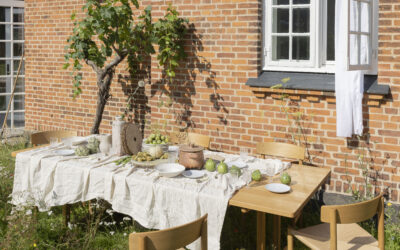How to get the best out of each dish with Gastronomy Influencers
With the festivities being right around the corner, we have found ourselves browsing through social media and the internet to find the perfect cake or roasted meat recipes, while coming across delightful recipes we also envy, and are inspired by the aesthetically pleasant looking tableware and kitchenware.
A beige table runner laying on a wooden dining table, white porcelain plates that perfectly match with the matte golden cutlery, a candle holder standing in the middle of the table – making the dining room warm and cozy. How can all these images in the feed not make us look forward to hosting dinners with family and friends?
Since the festivities are just a month away, our research team noticed the increased need to update and bring forward our “Gastronomy” list, to selectively showcase the most prominent gastronomy influencers and magazines. Scroll down to learn more about them and the relevance of gastronomy across markets.
The Pandemic: Where it all started
Although it has been hard to endure staying at home, and seeing our favourite restaurants with closed doors, the pandemic turned many of us into real foodies. It all started from baking the simplest banana bread to making delightful home-cooked dishes.
Social media were a big factor when it came to finding our favorite recipes. Nisha Chittal, editor at VOX mentioned that Instagram was loaded with sourdough and cookies recipes, and people liked to show off their home cooks through stories. Although not everyone is not much of a baker, many joined the newest cooking trends, and we all stumbled upon appetizing images of food presented in minimalistic settings with matching tableware, making us engage with narratives, that almost bring out the flavor through the screen.
Social media accounts dedicated to food became increasingly popular. In fact, studies have shown that there is a rising amount of people that now turn to social media for cooking inspiration, and 71% of people have now gone digital by getting inspiration from Instagram, where tags such as #foodporn have been used more than 400 million times, showing how social media users are connected to visual displays of food. Social media encouraged many to become “self-proclaimed” foodies which also made us look toward to hosting dinners with our long-time-no-see friends and family and showcasing our newest cooking skills.
With tags such as #tablescapes being increasingly used, many also realized the importance of table- and kitchen-ware. Online furniture stores, saw a strong demand for table and kitchenware, as more people have been eating and cooking at home. Luxury retailer The RealReal, saw that sales within its home category have risen by 16% over a year, with tableware being at the top of the sales. Whether it is when sharing your home-cooked dishes on social media or when hosting dinners, purchasing better tableware and kitchen tools became essential to create aesthetic social media images and a cozy atmosphere in the dining room.
It’s about storytelling
Nowadays, foodie enthusiasts do not just purchase porcelain plates from seeing a raw product image, they need something more; storytelling. And because brands today are not only seeking to have customers buying their products, but also want to have loyalties with their customers, storytelling is a valuable way to do so.
As a brand, there are various ways in which you can think about combining your products with food, and let everyone engage with the narrative behind your images. People often need to feel connected to the images they see, and as a brand, you want to trigger an emotional connection: to fantasize about dinner parties, Sunday morning brunches, and many more precious moments that we attach to food.
If you need inspiration, our research team previously released an article about gastronomy and storytelling and suggested several hacks on how to combine storytelling with food.
Gastronomy Across Markets
As a brand, it is essential to have insights into how markets value and perceive gastronomy. Whether a country considers Christmas, Easter or even afternoon coffee and cake to be important events will tell you much about a country’s gastronomy principles and how much care is being put on the table and kitchenware. Our international research team gathered gastronomy insights from their own markets to give you a better idea of how various markets value and perceive gastronomy.
Ema is the Lifestyle Researcher for the French market at VOCAST. She grew up in Brussels and previously worked with fashion PR. She is currently studying for a master’s degree in International Development and Business and has a strong interest in sustainable and ethical practices within the fashion industry.
SIGN UP TO OUR NEWSLETTER
Get free knowledge on how to optimize your B2B marketing & new product releases.
RELATED POSTS
The Art of Slow Living: When Thoughtful Choices Redefine Design
With a fast-paced everyday life, the principles of slow living stand in a sharp and perhaps comforting contrast. As the movement progresses, more people are integrating the values of slow living into all areas of their lives – from slow food to slow fashion and slow...
Mastering Sustainable Branding in Interior Design
In recent years, the appeal of trendy marble coffee tables, plush sofas, and finely designed lamps has captivated us all. While the interior design industry often embodies craftsmanship, it also has a less glamorous side: its environmental impact. This reality has...
Beyond the Aesthetic: The Emergence of Stylists as Influencers
In the realm of interior design, stylists, recognized for turning creative visions into captivating editorial and commercial projects, are increasingly emerging as key influencers on social media. The rise of digital platforms has substantially redefined their roles,...




